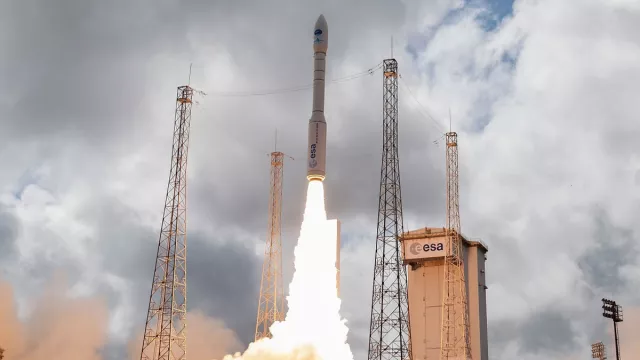In developing a light launcher from 1998 onwards, spacefaring Europe laid the foundations for future Earth-observation satellites. Vega’s performance and reliability rapidly established it in its market segment and it today rounds out Europe’s launch services offering to low Earth and polar orbits.
Key information
| Mission | Launch of small satellites to low Earth orbit |
|---|---|
| Domain | Space transportation |
| Launch date | First launch 13 February 2012 |
| Partners | ESA, ASI, industry contractors |
| Where | Guiana Space Centre (CSG), ELA-1 |
| Lifetime | 12 years |
| Status | Completed |
Key figures
- 20 successful flights between 2012 and 2024
- 30 m high
- 2.3 tonnes lift capacity to low Earth orbit
- 1.5 tonnes lift capacity to low Earth polar orbit
Key milestones
- 4 September 2024: Last Vega launch carrying Sentinel-2C satellite
- 9 October 2023: Vega launch carrying 12 satellites, microsatellites and nanosatellites
- 1 January 2018: Development and production transferred from Spacelab S.p.a (ex-ELV S.p.a) to Avio S.p.a
- 13 February 2012: First Vega launch carrying LARES and 8 microsatellites and nanosatellites
- 20 October 2004: Work gets underway to adapt ELA-1 launch pad at CSG
- 21 February 2001: Avio and Italian space agency ASI found ELV S.p.a to take charge of development and production
- 24 June 1998: ESA gives go-ahead to develop Vega
Project in brief
The decision to develop a launcher with an all-new architecture to orbit European and commercial small satellites was not without risk. But work got underway in 2000 and this challenge was accomplished in February 2012 with the first flight of Vega. Between 2012 and 2024, it was a fixture of the European space launch landscape alongside the Soyuz medium-lift launcher and the more powerful Ariane 5, operating out of the Guiana Space Centre in Kourou. It lifted off from the pad formerly dedicated to Ariane 1, ELA-1, completely refurbished to accommodate the light launcher at the beginning of the century.
Relying on solid propulsion, a French-Italian domain of space technological excellence, Vega is composed of three solid-propellant stages—P-80, Zefiro Z-23 and Z-9—and the AVUM liquid-propellant upper stage.
Vega has become a stalwart for Earth-observation and imaging satellites, with a track record of 20 successful flights out of 22 (as of 2024). The launcher has demonstrated its capabilities across a broad range of mission profiles, from suborbital flights to a scientific probe 1.5 million kilometres from Earth.
Operated by Arianespace, the Vega launcher thus closes a 12-year career with 22 launches to its credit. It now gives way to the Vega-C rocket, which is scheduled to return to flight by the end of 2024 at the Guiana Space Center.
CNES’s role
The prime contractor in charge of development and production of Vega was Italian firm Avio S.p.A, which has acquired the launcher system business of ELV S.p.A, a joint venture owned 70% by Avio and 30% by the Italian space agency set up at the start of the project. CNES played a prime role in the early phases of the project, notably on studies and development of Vega’s P80 solid-propellant first-stage engine and on ground work, interfacing with the CSG and launch site.
Contacts
Vega Project Leader
Fleur Lefèvre
E-mail: fleur.lefevre at cnes.fr
Vega Senior Project Leader
Eric Robert
E-mail: eric.robert at cnes.fr
Head of Space Transportation Strategy
Philippe Pujès
E-mail: philippe.pujes at cnes.fr


